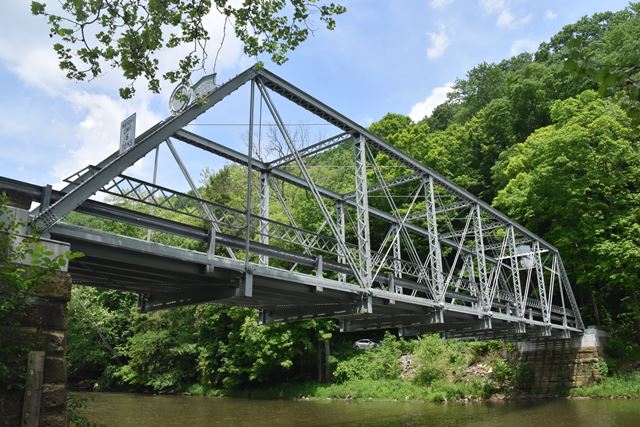We Recommend:
Bach Steel - Experts at historic truss bridge restoration.
BridgeHunter.com Phase 1 is released to the public! - Visit Now
Echo Dell Road Bridge

Primary Photographer(s): Nathan Holth
Bridge Documented: May 29, 2018
Rural: Columbiana County, Ohio: United States
1910 By Builder/Contractor: Central Concrete and Construction Company of Canton Ohio and Canton Bridge Company of Canton, Ohio
2009
127.0 Feet (38.7 Meters)
129.0 Feet (39.3 Meters)
12.5 Feet (3.81 Meters)
1 Main Span(s)
1537741

View Information About HSR Ratings
Bridge Documentation
View Archived National Bridge Inventory Report - Has Additional Details and Evaluation
This classic Pratt truss bridge with attractive plaques has been rehabilitated for vehicular traffic in this scenic park setting. This bridge would have originally had portal cresting which has been lost. The connector stubs remain on the portal bracing. The ornate plaques were a standard design of the Canton Bridge Company in the early 20th Century. The eastern builder plaque reads Central Concrete Construction Company of Canton, Ohio, while the west builder plaque reads Canton Bridge Company of Canton, Ohio. These two companies often worked together on projects.
This bridge is well-maintained and was rehabilitated recently. is located in Beaver Creek State Park, making it a focus attraction for the park. A stone arch bridge and locks are nearby.
Information and Findings From Ohio's Historic Bridge InventorySetting/Context The bridge carries a 2 lane road over a stream in Beaver Creek State Park. May not be the bridge's original location. Physical Description The 1 span, 129'-long, pin-connected Pratt thru truss bridge has built-up compression members and eyebar tension members. The A-frame portals sport over-sized decorative medallions and builders plaques. Integrity Scheduled for rehabilitation in 2008. Summary of Significance The 1909-10 pin-connected Pratt thru truss bridge is a complete, but later example of a common type/design. It has been determined eligible as the result of advancing a rehabilitation project (SHPO letter, 5/21/08). Pratt trusses were undoubtedly the most popular truss design of the last quarter of the 19th century and continued to be built into the 20th century, although eventually superseded in popularity by Warren trusses. The design, which initially was a combination of wood compression and iron tension members, was patented in 1844 by Thomas & Caleb Pratt. Ohio has three covered bridges that use this combination configuration, but they are all modern reconstructions based on the Pratt patent. The great advantage of the Pratt over other designs was the relative ease of calculating the distribution of stresses. More significantly, it translated well into an all-metal design in lengths of less than 200'. Significant surviving examples of all-metal Pratt trusses mostly date to the last quarter of the 19th century, and they are found with thru, pony, and the less common bedstead configuration. Prior to about 1890, a variety of panel point connections were in widespread use (including bolts, cast-iron pieces, and pins), but engineering opinion was coalescing around pins as the most efficient and constructible. Many of the connection details were proprietary and associated with individual builders or companies, and thus earlier examples are generally taken to be technologically significant in showing the evolution of the design. Later post-1890 Pratt trusses show a progression toward less variation in their details such that by 1900 the design was quite formulaic with few significant differences between the designs of various builders. This marked the end of the pin-connected Pratt's technological evolution and, in fact, it was soon waning and eclipsed in the highway bridge market by more rigid, rivet-connected truss designs, particularly the Warren but also riveted Pratts. The transition to riveted connections, which happened even earlier with railroads than highways, was in no small part due to concerns about stress reversals at the pins under heavier loads and improvements in pneumatic field riveting equipment in the early 1900s. In Ohio, Pratt truss highway bridges, whether pinned or riveted, were almost always built under the auspices of counties and local units of government; the Pratt was not a standard design of the state highway department. In Ohio, there are 185 Pratt trusses dating from ca. 1874 to 1945 with at least 60 dating prior to 1900 (Phase 1A, 2008). The technologically significant unaltered examples of pin-connected Pratt trusses for the most part date prior to 1900 and have documented or attributed builders and dates of construction and/or significant connection or member details. Later post-1900 examples are less technologically significant. Significant unaltered examples of riveted-connected Pratt trusses date from ca. 1900 to 1915. Justification The bridge is one of over 150 extant pin-connected truss bridges dating from 1874 for pony trusses and 1876 for thru trusses. Twenty six predate 1888 and represent the era of experimentation that evolved into standardized designs by about 1888. This example has moderate significance because the genre and the fabricator are so well represented in Ohio. Bridge Considered Historic By Survey: Yes |
![]()
Photo Galleries and Videos: Echo Dell Road Bridge
Bridge Photo-Documentation
Original / Full Size PhotosA collection of overview and detail photos. This gallery offers photos in the highest available resolution and file size in a touch-friendly popup viewer.
Alternatively, Browse Without Using Viewer
![]()
Bridge Photo-Documentation
Mobile Optimized PhotosA collection of overview and detail photos. This gallery features data-friendly, fast-loading photos in a touch-friendly popup viewer.
Alternatively, Browse Without Using Viewer
![]()
Maps and Links: Echo Dell Road Bridge
Coordinates (Latitude, Longitude):
Search For Additional Bridge Listings:
Bridgehunter.com: View listed bridges within 0.5 miles (0.8 kilometers) of this bridge.
Bridgehunter.com: View listed bridges within 10 miles (16 kilometers) of this bridge.
Additional Maps:
Google Streetview (If Available)
GeoHack (Additional Links and Coordinates)
Apple Maps (Via DuckDuckGo Search)
Apple Maps (Apple devices only)
Android: Open Location In Your Map or GPS App
Flickr Gallery (Find Nearby Photos)
Wikimedia Commons (Find Nearby Photos)
Directions Via Sygic For Android
Directions Via Sygic For iOS and Android Dolphin Browser
USGS National Map (United States Only)
Historical USGS Topo Maps (United States Only)
Historic Aerials (United States Only)
CalTopo Maps (United States Only)

